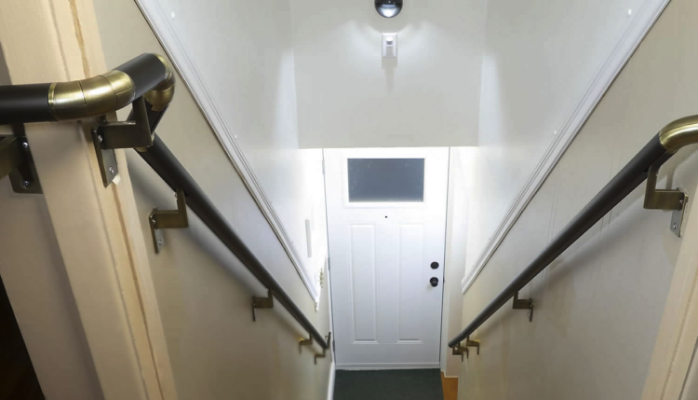The following are excerpts from Promenaid, a handrail system designed to be easy to install and that answers the concerns of fall prevention around a home.
“There’s an old riddle that asks, “What has four legs in the spring, two in the summer, and three in the fall?”
The answer is “a human”. We start life on four legs, walk on two legs in the “summer” of our lives, and require a cane when we get older. As we age, we need three points of contact for stability.
No parent would dream of leaving a toddler at the top of the stairs unprotected by a gate, yet we fail to consider mobility and falls prevention for the aging-in-place.
Every year, more than 25,000 seniors die and millions are hospitalized in North America as a result of falls.
The number of deaths from accidental falls has nearly doubled over the past decade. More than half of these falls occur in the home.
Handrails are on every falls-prevention and aging-in-place checklist.
In most of North America, law for safety and accessibility in every public place requires handrails. And yet handrails are almost never found in the home. Not even in the homes of the aging or the mobility-impaired where they are needed the most.
That’s because PromenAid is the first and only true handrail for the home.
There are plenty of railings for the home, but…
Railings are not handrails.
Railings are on top of balusters on a stairway, primarily to prevent falling off the side of the stairs, not to prevent falling down the stairs.
Decorative wooden railings, whether for balusters or walls, are designed to mimic stair railings of 150 years ago.
Imagine trying to use a hammer if the handle were shaped like a stair railing.
Railings that provide a ‘pinch grip’ are not adequate to fully assist with mobility let alone to prevent a fall. This is especially true for small or frail hands.
Handrails have the profile for a ‘power grip’, which studies demonstrate is five times stronger than a ‘pinch grip
A handrail, according to the Americans With Disabilities Act and most accessibility and safety standards worldwide, is:
- 1 1/2” – 2” in diameter
- Round (or equivalent)
- A minimum of 1 1/2” from the wall
- At least 1 1/2” above any horizontal protrusion
- Continuous on and between stairs, ramps, landings and horizontal extensions at the tops and bottoms of slopes
A handrail must withstand at least 500 lb-feet of force to satisfy the International Building Code commercial standard.
Sometimes you find a railing attached to the wall, pretending to be a handrail.
It might even be called a handrail in the hardware store. But it’s really just a railing.
A handrail is a handrail when:
- It’s strong enough to support your weight and prevent you from falling.
- It has the round 1 1/2” – 2” diameter profile required for a power grip.
- It is 1 1/2” from the wall and unobstructed by brackets.
- It is smooth and continuous around corners and bends.
Making a true handrail that looks good and is practical to install in the home might seem simple, but it’s not.
We had to invent the technology to do it.
- Exceeds all residential and commercial codes
- Optimal gripping profile
- Strong and durable
- Continuous around corners and slopes
- Can be used anywhere, indoors and out, wet or dry
- Integrates with any décor
- Low installed cost
- Days, not weeks, from order to installation
Our product addresses:
- Safety
- Mobility
- IS ultra-quick and easy installation
- Provides three points of continuous contact wherever it’s needed”
Contact PromenAid™
The first and only true handrail for the home.
promenaid.com
(888) 992-4943

